2001 FORD F350 air conditioning
[x] Cancel search: air conditioningPage 23 of 288

4. Press and hold both trip
computer controls. After
approximately four seconds, the trip
computer will enter zone setting
mode. Zone setting mode is
indicated when the display lights the
“ZONE” indicator.
5. Release both controls.
Subsequent pressing of either
control will increment the zone.
Press the control repeatedly until
the correct zone setting for your geographic location is displayed on the
trip computer.
6. To exit the zone setting mode and save the displayed zone in memory,
release both controls for greater than five seconds.
Compass calibration adjustment
Perform this adjustment in an open area free from steel structures and
high voltage lines.
For optimum calibration, turn off all electrical accessories (heater/air
conditioning, wipers, etc.) and make sure all vehicle doors are shut.
1. Locate the trip computer located in the overhead console.
2. Start the vehicle.
3. Press and hold both trip
computer controls. After
approximately eight seconds, the
trip computer will enter CAL mode.
CAL mode is indicated when the
display lights the “CAL” indicator.
4. Release both controls. The display
will return to normal, except that
the CAL indicator will remain lit
until the compass is sucessfully
calibrated.
5. Slowly drive the vehicle in a circle (less than 5 km/h [3 mph]) until
the CAL indicator turns off. It may take up to five circles to complete
calibration.
6. The compass is now calibrated.
Instrumentation
23
ProCarManuals.com
Page 31 of 288
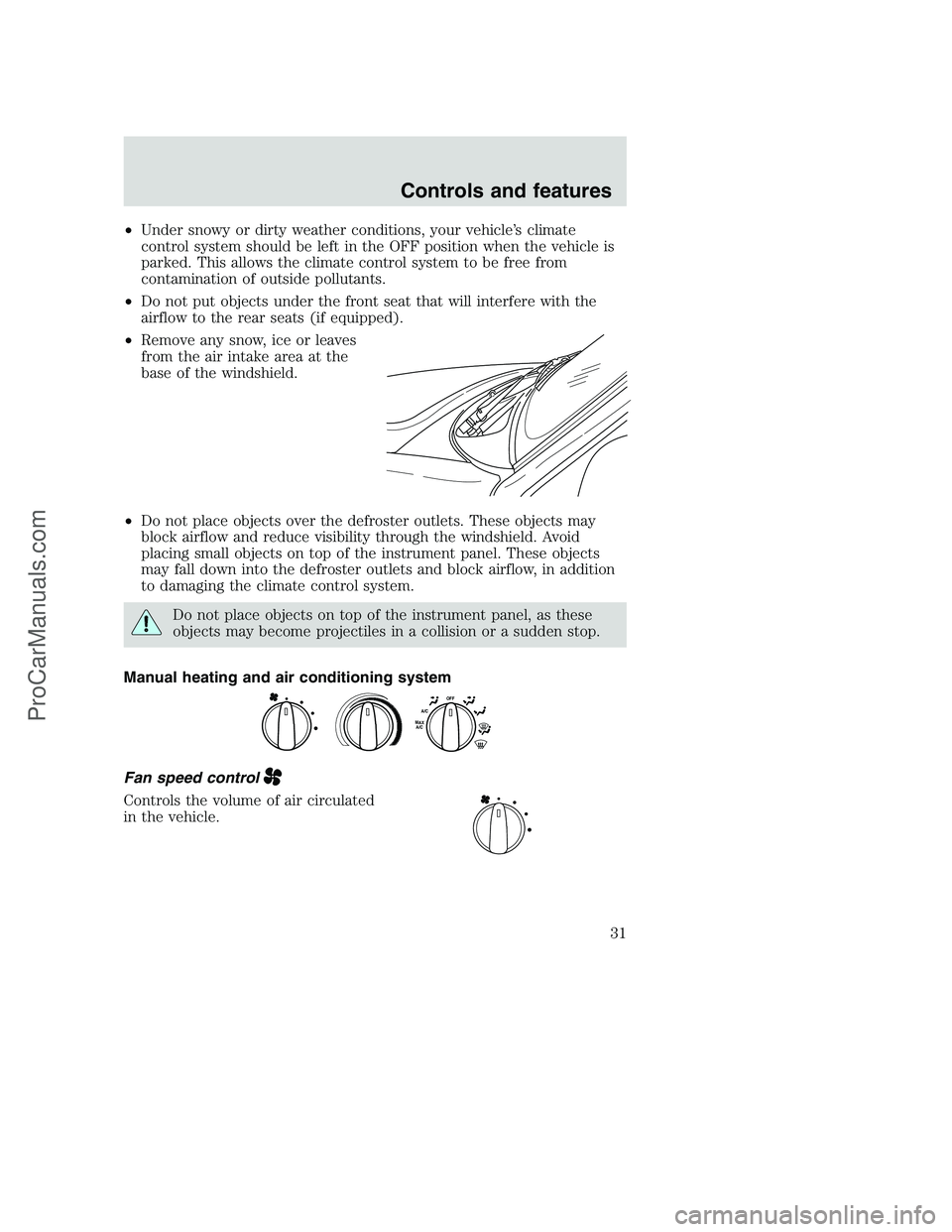
•Under snowy or dirty weather conditions, your vehicle’s climate
control system should be left in the OFF position when the vehicle is
parked. This allows the climate control system to be free from
contamination of outside pollutants.
•Do not put objects under the front seat that will interfere with the
airflow to the rear seats (if equipped).
•Remove any snow, ice or leaves
from the air intake area at the
base of the windshield.
•Do not place objects over the defroster outlets. These objects may
block airflow and reduce visibility through the windshield. Avoid
placing small objects on top of the instrument panel. These objects
may fall down into the defroster outlets and block airflow, in addition
to damaging the climate control system.
Do not place objects on top of the instrument panel, as these
objects may become projectiles in a collision or a sudden stop.
Manual heating and air conditioning system
Fan speed control
Controls the volume of air circulated
in the vehicle.
O
F
FA/CM
A
X
A
/
C
Controls and features
31
ProCarManuals.com
Page 32 of 288
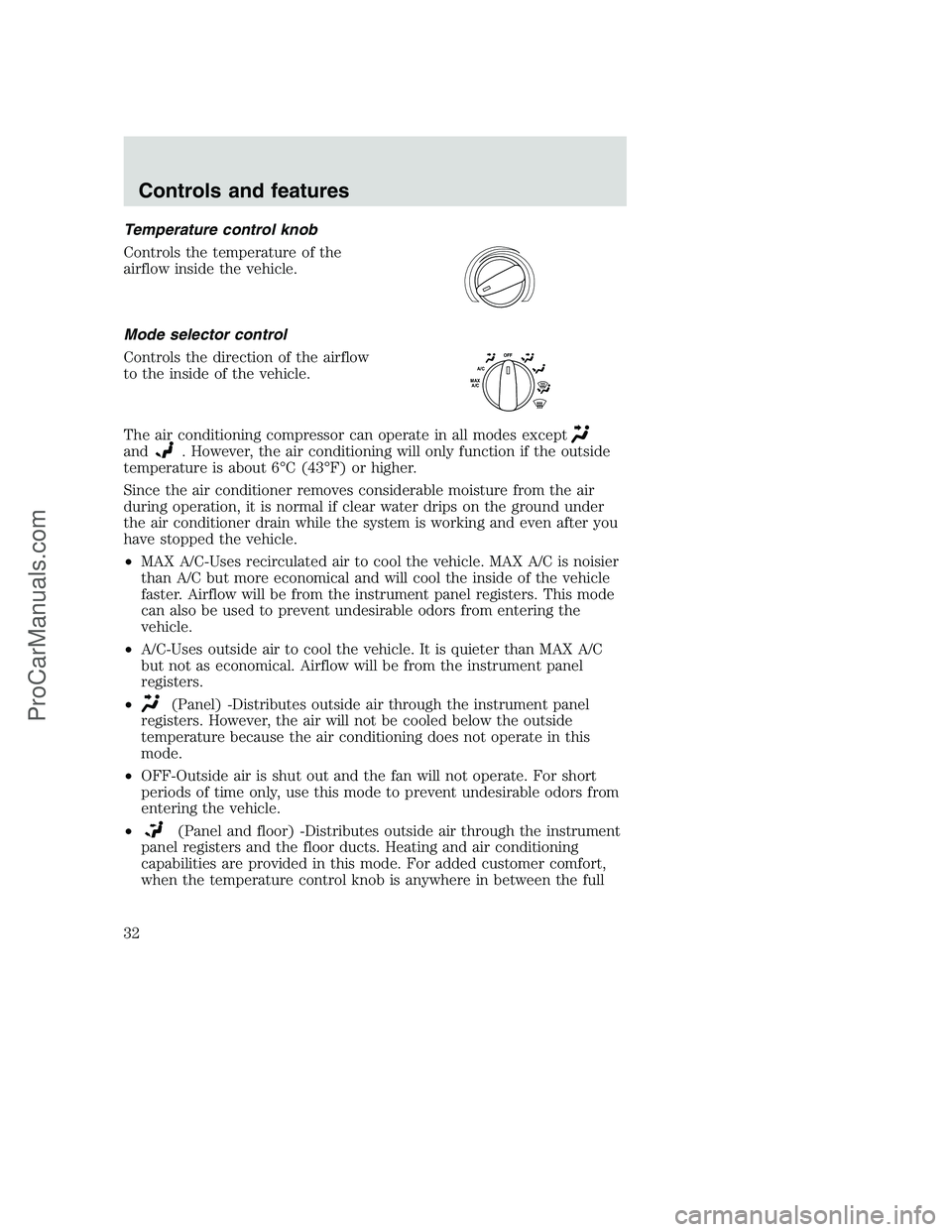
Temperature control knob
Controls the temperature of the
airflow inside the vehicle.
Mode selector control
Controls the direction of the airflow
to the inside of the vehicle.
The air conditioning compressor can operate in all modes except
and. However, the air conditioning will only function if the outside
temperature is about 6°C (43°F) or higher.
Since the air conditioner removes considerable moisture from the air
during operation, it is normal if clear water drips on the ground under
the air conditioner drain while the system is working and even after you
have stopped the vehicle.
•MAX A/C-Uses recirculated air to cool the vehicle. MAX A/C is noisier
than A/C but more economical and will cool the inside of the vehicle
faster. Airflow will be from the instrument panel registers. This mode
can also be used to prevent undesirable odors from entering the
vehicle.
•A/C-Uses outside air to cool the vehicle. It is quieter than MAX A/C
but not as economical. Airflow will be from the instrument panel
registers.
•
(Panel) -Distributes outside air through the instrument panel
registers. However, the air will not be cooled below the outside
temperature because the air conditioning does not operate in this
mode.
•OFF-Outside air is shut out and the fan will not operate. For short
periods of time only, use this mode to prevent undesirable odors from
entering the vehicle.
•
(Panel and floor) -Distributes outside air through the instrument
panel registers and the floor ducts. Heating and air conditioning
capabilities are provided in this mode. For added customer comfort,
when the temperature control knob is anywhere in between the full
O
F
FA/CM
A
X
A
/
C
Controls and features
32
ProCarManuals.com
Page 33 of 288
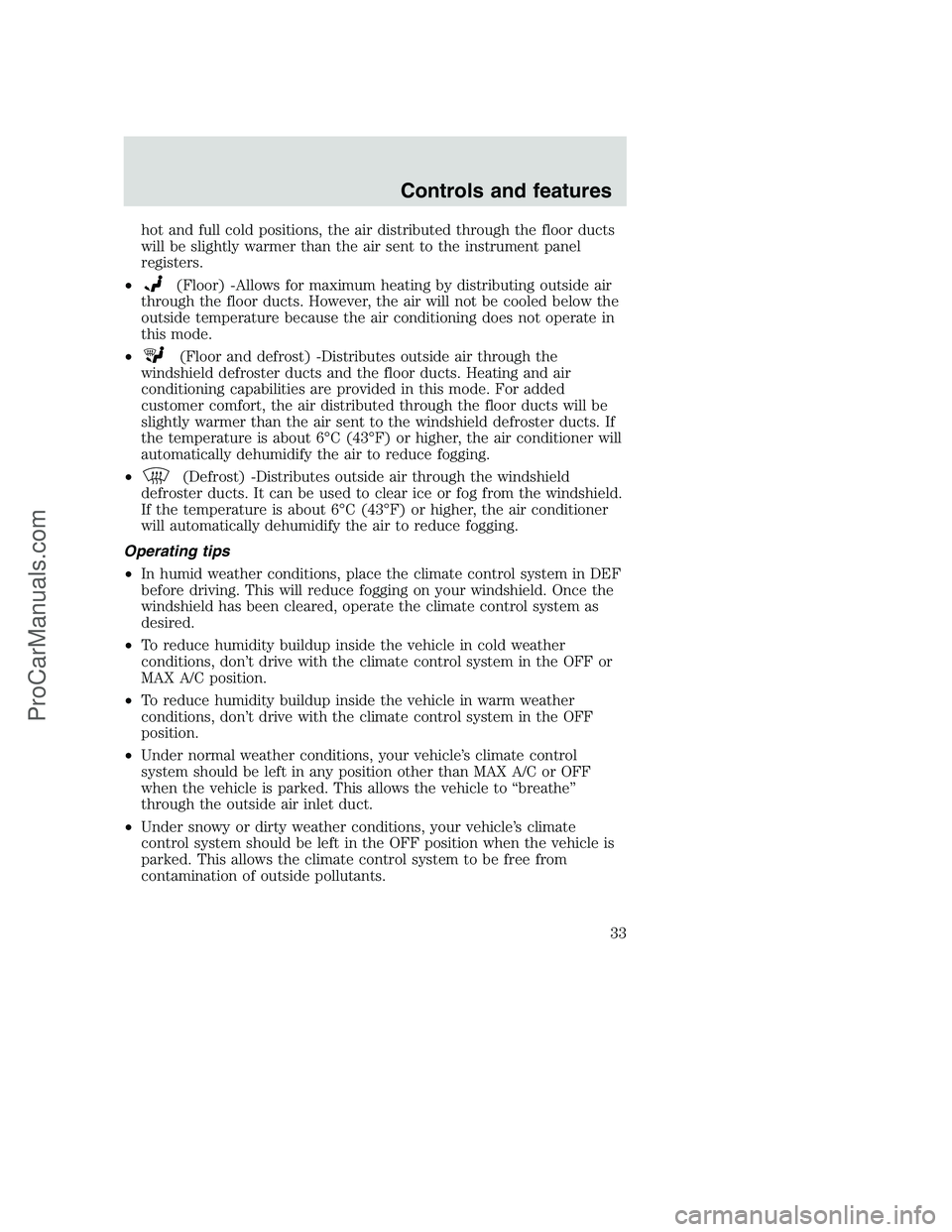
hot and full cold positions, the air distributed through the floor ducts
will be slightly warmer than the air sent to the instrument panel
registers.
•
(Floor) -Allows for maximum heating by distributing outside air
through the floor ducts. However, the air will not be cooled below the
outside temperature because the air conditioning does not operate in
this mode.
•
(Floor and defrost) -Distributes outside air through the
windshield defroster ducts and the floor ducts. Heating and air
conditioning capabilities are provided in this mode. For added
customer comfort, the air distributed through the floor ducts will be
slightly warmer than the air sent to the windshield defroster ducts. If
the temperature is about 6°C (43°F) or higher, the air conditioner will
automatically dehumidify the air to reduce fogging.
•
(Defrost) -Distributes outside air through the windshield
defroster ducts. It can be used to clear ice or fog from the windshield.
If the temperature is about 6°C (43°F) or higher, the air conditioner
will automatically dehumidify the air to reduce fogging.
Operating tips
•In humid weather conditions, place the climate control system in DEF
before driving. This will reduce fogging on your windshield. Once the
windshield has been cleared, operate the climate control system as
desired.
•To reduce humidity buildup inside the vehicle in cold weather
conditions, don’t drive with the climate control system in the OFF or
MAX A/C position.
•To reduce humidity buildup inside the vehicle in warm weather
conditions, don’t drive with the climate control system in the OFF
position.
•Under normal weather conditions, your vehicle’s climate control
system should be left in any position other than MAX A/C or OFF
when the vehicle is parked. This allows the vehicle to “breathe”
through the outside air inlet duct.
•Under snowy or dirty weather conditions, your vehicle’s climate
control system should be left in the OFF position when the vehicle is
parked. This allows the climate control system to be free from
contamination of outside pollutants.
Controls and features
33
ProCarManuals.com
Page 130 of 288
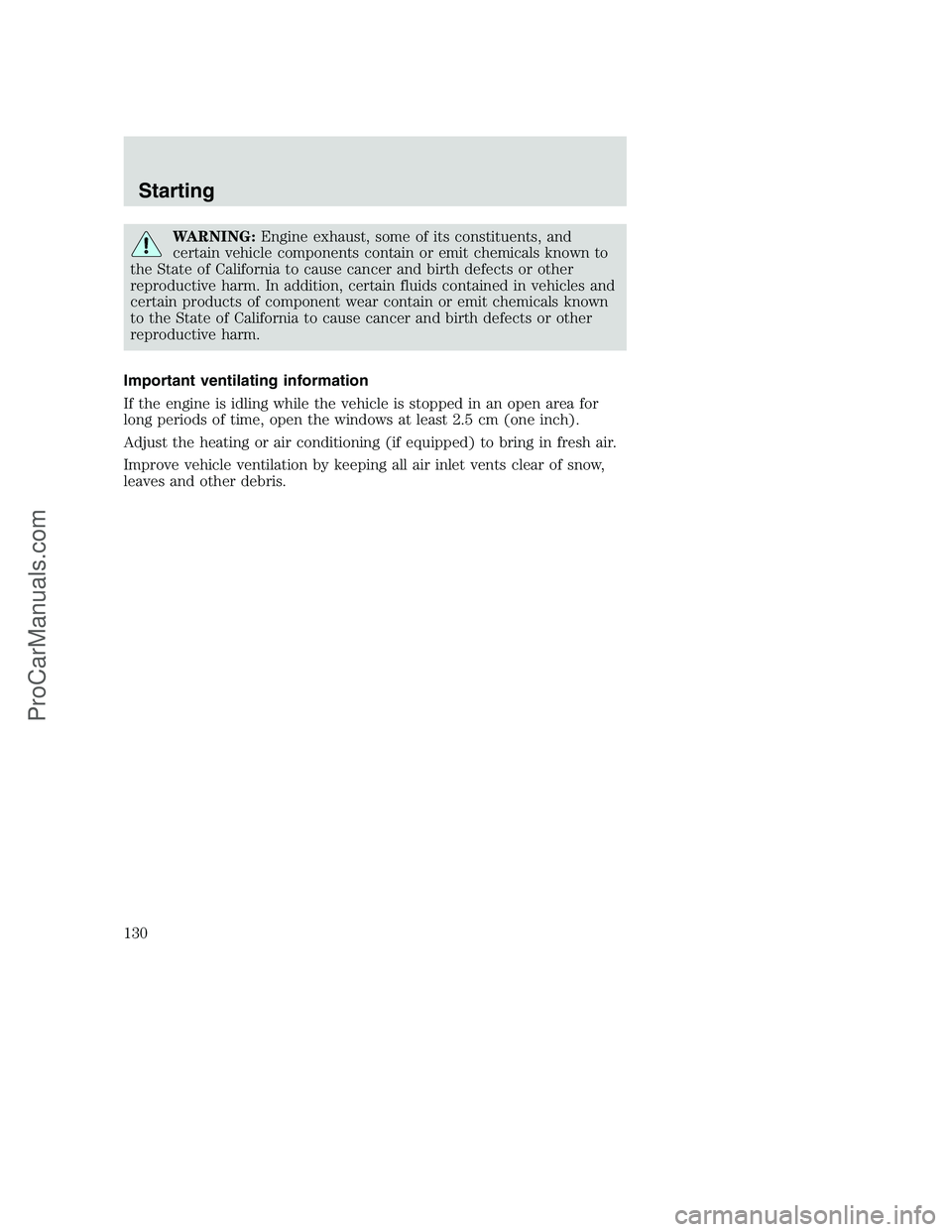
WARNING:Engine exhaust, some of its constituents, and
certain vehicle components contain or emit chemicals known to
the State of California to cause cancer and birth defects or other
reproductive harm. In addition, certain fluids contained in vehicles and
certain products of component wear contain or emit chemicals known
to the State of California to cause cancer and birth defects or other
reproductive harm.
Important ventilating information
If the engine is idling while the vehicle is stopped in an open area for
long periods of time, open the windows at least 2.5 cm (one inch).
Adjust the heating or air conditioning (if equipped) to bring in fresh air.
Improve vehicle ventilation by keeping all air inlet vents clear of snow,
leaves and other debris.
Starting
130
ProCarManuals.com
Page 211 of 288

Refer to the chart on the coolant container to ensure the coolant
concentration in your vehicle will provide adequate freeze protection.
Never increase the engine coolant concentration above 60%
(protection to –60°F). At a level over 60%, your engine could overheat
and become damaged.
If you drive in extremely hot climates, it is still necessary to maintain the
coolant concentration at 50/50 coolant and water.Do not allow the
coolant concentration to fall below 40% coolant.At a concentration
less than 40%, the corrosion protection to your engine and cooling
components may be compromised and permanent damage may result.
What you should know about fail-safe cooling (if equipped)
If the engine coolant supply is depleted, this feature allows the vehicle to
be driven temporarily before incremental component damage is incurred.
The “fail-safe” distance depends on ambient temperatures, vehicle load
and terrain.
How fail-safe cooling works
If the engine begins to overheat:
•The engine coolant temperature
gauge will move to the red (hot)
area.
•The
andsymbol will
illuminate.
•TheService Engine Soon
indicator light will illuminate.
If the engine reaches a preset over-temperature condition, the engine
will automatically switch to alternating cylinder operation. Each disabled
cylinder acts as an air pump and cools the engine.
When this occurs the vehicle will still operate. However:
•The engine power will be limited.
•The air conditioning system will be disabled.
Continued operation will increase the engine temperature and the engine
will completely shut down, causing steering and braking effort to
increase.
Once the engine temperature cools, the engine can be re-started. Take
your vehicle to a service facility as soon as possible to minimize engine
damage.
H
C
Maintenance and care
211
ProCarManuals.com
Page 278 of 288

A
Accessory delay ..........................80
Air bag supplemental
restraint system ........................107
and child safety seats ............109
description ..............................107
disposal ....................................111
driver air bag ..........................109
indicator light ...................11, 111
operation .................................109
passenger air bag ...................109
passenger deactivation
switch ......................................112
Air cleaner filter .......217–218, 249
Air conditioning ..........................29
Ambulance packages ....................4
Antifreeze (see Engine
coolant) .....................................206
Anti-lock brake system
(see Brakes) ......................131–132
Audio system (see Radio) ...35, 56
Automatic transmission
driving an automatic
overdrive .................................137
fluid, adding ............................214
fluid, checking ........................214
fluid, refill capacities ..............249
fluid, specification ..................256
Auxiliary power point ...........29, 83
Axle
lubricant specifications ..253, 256
refill capacities ........................249
traction lok ..............................134
B
Battery .......................................219acid, treating emergencies .....219
charging system
warning light .............................13
jumping a disabled battery ....191
maintenance-free ....................219
replacement, specifications ...249
servicing ..................................219
voltage gauge ............................19
Belt minder ...............................103
Brakes ........................................131
anti-lock ...........................131–132
anti-lock brake system
(ABS) warning light .........13, 132
brake warning light ..................12
fluid, checking and adding ....204
fluid, refill capacities ..............249
fluid, specifications .........253, 256
lubricant specifications ..253, 256
parking ....................................133
pedals (see Power adjustable
foot pedals) ...............................26
shift interlock ..........................136
Break-in period .............................3
C
Capacities for refilling fluids ....249
Certification Label ....................261
Child safety restraints ..............117
child safety belts ....................117
Child safety seats ......................118
attaching with tether straps ..122
in front seat ............................119
in rear seat ..............................119
tether anchorage hardware ...122
Cleaning your vehicle ...............243
engine compartment ..............246
exterior ............................244–245
exterior lamps .........................246
Index
278
ProCarManuals.com
Page 279 of 288
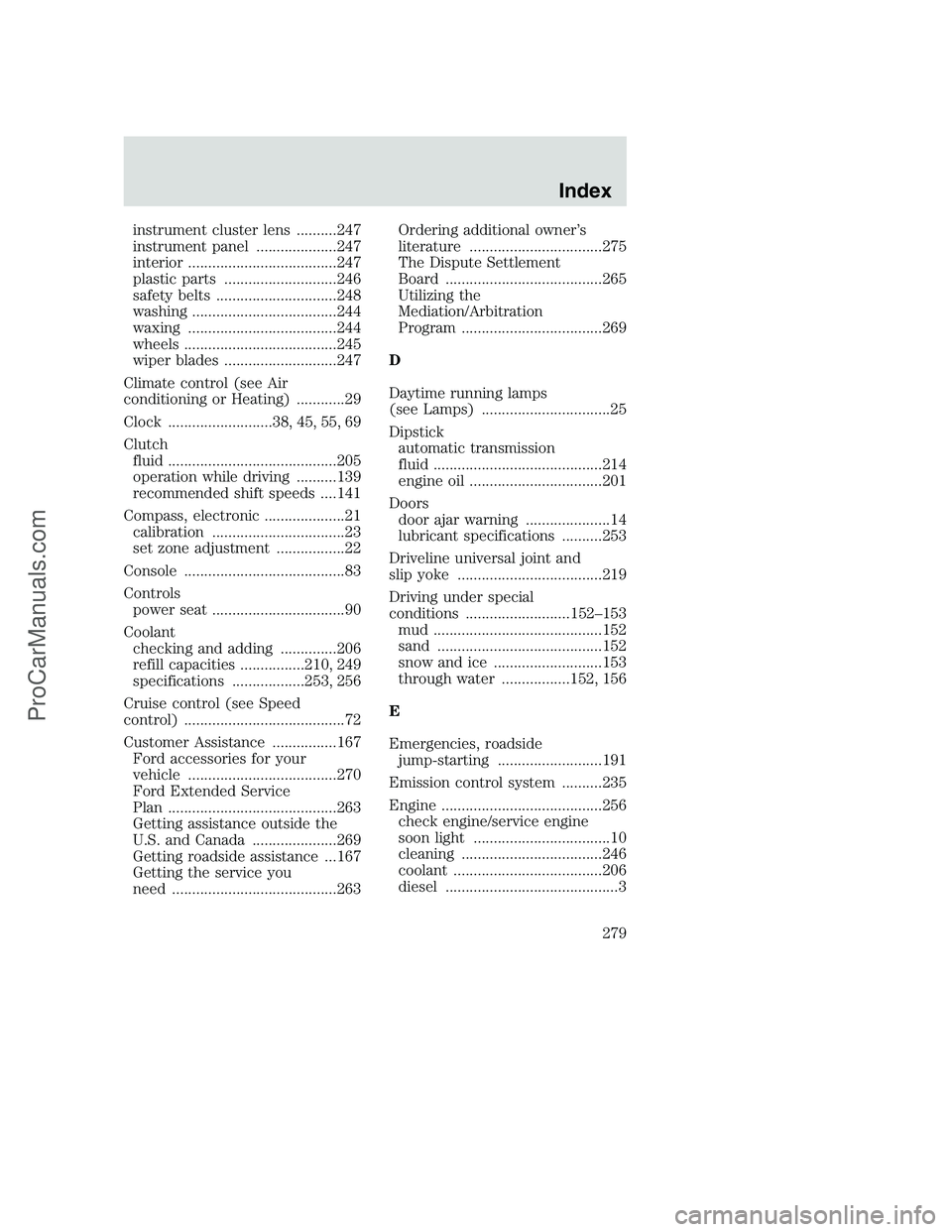
instrument cluster lens ..........247
instrument panel ....................247
interior .....................................247
plastic parts ............................246
safety belts ..............................248
washing ....................................244
waxing .....................................244
wheels ......................................245
wiper blades ............................247
Climate control (see Air
conditioning or Heating) ............29
Clock ..........................38, 45, 55, 69
Clutch
fluid ..........................................205
operation while driving ..........139
recommended shift speeds ....141
Compass, electronic ....................21
calibration .................................23
set zone adjustment .................22
Console ........................................83
Controls
power seat .................................90
Coolant
checking and adding ..............206
refill capacities ................210, 249
specifications ..................253, 256
Cruise control (see Speed
control) ........................................72
Customer Assistance ................167
Ford accessories for your
vehicle .....................................270
Ford Extended Service
Plan ..........................................263
Getting assistance outside the
U.S. and Canada .....................269
Getting roadside assistance ...167
Getting the service you
need .........................................263Ordering additional owner’s
literature .................................275
The Dispute Settlement
Board .......................................265
Utilizing the
Mediation/Arbitration
Program ...................................269
D
Daytime running lamps
(see Lamps) ................................25
Dipstick
automatic transmission
fluid ..........................................214
engine oil .................................201
Doors
door ajar warning .....................14
lubricant specifications ..........253
Driveline universal joint and
slip yoke ....................................219
Driving under special
conditions ..........................152–153
mud ..........................................152
sand .........................................152
snow and ice ...........................153
through water .................152, 156
E
Emergencies, roadside
jump-starting ..........................191
Emission control system ..........235
Engine ........................................256
check engine/service engine
soon light ..................................10
cleaning ...................................246
coolant .....................................206
diesel ...........................................3
Index
279
ProCarManuals.com